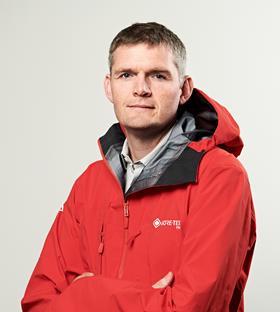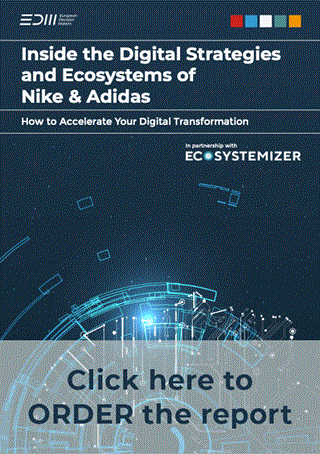The clothing industry has been waiting for a PFC-free membrane from market leader W. L. Gore & Associates. Now the time has come: The first ePE products will be launched as early as next fall with selected brand partners. What exactly is the new membrane made of, and what are its advantages? We asked Ross MacLaine, Sustainability Leader Fabrics Division at W. L. Gore & Associates.

Gore is just launching a product the industry has been waiting for. A PFC-free, more sustainable membrane. What kind of membrane is that?
Ross MacLaine: Maybe we should first take a step back and look at what we’ve been looking for and what a new Gore material has to be able to do: It has to be thin, lightweight, highly breathable, and it also has to reduce our carbon footprint. And with all the requirements, it was always extremely important for us that it was durable. We want to make products that are durable. That way, we can make sure that the footprint of our products can be spread over a long lifetime.
Finding and developing a material like that doesn’t happen overnight. We had to look at many, many materials until we found something that worked. And over time, our enthusiasm for polyethylene grew. It’s not a new material per se; polyethylene membranes have been around for a while for various applications. With our 40 years of know-how in processing PTFE, we were scientifically and technically able to process the material in a way that no one had done before. So we tried to figure out how to expand PE to get the microporous structure. Combined with polyurethane, you get a durable, waterproof, windproof, breathable material.
To what extent are the ePE membrane and its processes more sustainable?
Ross MacLaine: Sustainability is something that is difficult to define and is interpreted differently by many people. What is important for our understanding is that if we were not able to maintain durability, the new membrane would have been a step in the wrong direction. Durability is a key point for our understanding of sustainability because being able to use a product for a long time is the most sustainable thing you can do.
Our membrane is PFC-free, and the DWR on the textile surfaces is also PFC-free. With this product, we are driving our goals to eliminate PFCs of environmental concern from our products. So the product is durable, PFC-free in terms of our specifications for PFCs of environmental concern, and we are improving our carbon footprint. Those are three very significant improvements in terms of sustainability that we’re achieving. Talking about the laminate, our products are bluesign approved, Standard 100 by Oeko-Tex certified; we use recycled materials in the laminate’s textile components and solution-dyed textiles, which saves water, chemicals and reduces carbon emissions.
Gore wanted to launch the first PFC-free product in 2023 – you’ve actually done it a little earlier!
Ross MacLaine: Yes, this product will be launched this fall, so consumers will be able to buy the first products with this membrane in stores around September. Initially, only at a few selected brand partners in the outdoor and lifestyle apparel, footwear and snowsports gloves categories. After that, the further roll-out will take place.
Are there also functional improvements with the new polyethylene material?
Ross MacLaine: Oh yes, for example, it has an excellent strength-to-weight ratio, which means we can make our products even thinner and lighter. But we also need less material, which is positive in terms of our resource efficiency and reduces our carbon footprint.
Will the new membrane be available for other applications in the future?
Ross MacLaine: I hope so. We have started with one membrane now, albeit for different categories like gloves, footwear and apparel and therefore with small differences. But our R&D team is, of course, continuing to work, and new possibilities will come out of that. There will certainly be more products for specific applications in the future.
Gore is known for its strict quality standards. Does the new membrane fulfill the “Guarantee to keep you dry”?
Ross MacLaine: Absolutely. This promise is an essential criterion for any product. When consumers see our new product in the store, they can absolutely trust it.
How should one imagine the discovery process, how did you develop the new material?
Ross MacLaine: The fundamental challenge is to deliver the performance that the end consumer and the industry expect: durable, long-lasting products that perform really well. That’s what Gore-Tex stands for in the apparel industry. How do you develop a new material? By investing years of hard work. Evaluating different materials, studying their properties, checking findings, conducting field tests, we did all that, discarded it again and again, and started all over again. The field tests, in particular, were important to us because it is imperative that our products really work. We spent months and years testing these materials in garments before we put them on the market. And we are very satisfied.
What has the switch to the new material meant for your processes?
Ross MacLaine: That depends on which production step you’re looking at. The production of the laminate was more or less simple and hardly different from our previous products. It was more difficult to adapt and control the expanding processes of the new material because all the properties, such as breathability, durability, weight, etc., depend on it. Ultimately, it was an evolutionary process and the further development of our very own expertise, just with a new material. The good thing is that we produce all our laminates in-house; we don’t outsource this process. This helped us a lot in developing the new product because we could control and adjust all the steps ourselves.
How much did the development cost?
Ross MacLaine: I can’t give a number, but it would be a big number. We worked on it for many years, and many people were involved.
Where did the development take place?
Ross MacLaine: We are a global company, so the development involved our facilities on the East Coast of the U.S. and in Germany, and later our facilities in Shenzhen, China, to scale up production. It was a very global effort that we made here.
Once again, on the subject of PFC-free: Gore uses the term PFCs of environmental concern. What exactly does this mean?
Ross MacLaine: The subject of PFCs is very complex, so it is often very simplified. The class of PFCs includes more than 5,000 substances, which in turn have an enormous range of properties. This ranges from volatile substances, which have justifiably come under criticism in recent years and are now eliminated in the supply chain, to PTFE, a very large, stable molecule. In 2017, we defined our goals to eliminate those substances that we call PFCs of environmental concern. So, we are eliminating a certain class of PFCs that we find of environmental concern. With this in mind, we are introducing a PFC-free product.
What is the goal: Is the new membrane to replace PTFE one day?
Ross MacLaine: We will be expanding the use of this new membrane as quickly as we can, and our plan is to expand it very broadly. In principle, however, further development depends on how the new membrane is accepted. At the same time, of course, we are also continuing to develop our existing technologies and improve them year by year.
What other sustainability plans does Gore have with the PTFE membrane?
Ross MacLaine: We have also made great progress with our other products in recent years. Often these have been improvements that may not have as much media impact as ePE, such as reducing the carbon footprint of our textiles or improving our energy efficiency. The textile accounts for the largest share of a laminate’s carbon footprint. So we continue working with recycled materials and with solution-dyed materials. ePE doesn’t solve all the problems, but it is part of the solution.
Last question, on price: Will the new membrane make the products more expensive?
Ross MacLaine: That is up to our partners; the retail price depends on many different factors. We cannot influence this. But I assume that the consumer will not notice a significant price increase.



